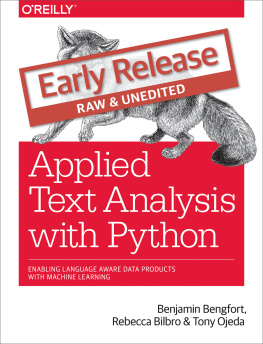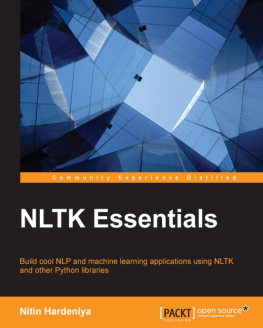Jalaj Thanaki [Thanaki - Python Natural Language Processing
Here you can read online Jalaj Thanaki [Thanaki - Python Natural Language Processing full text of the book (entire story) in english for free. Download pdf and epub, get meaning, cover and reviews about this ebook. year: 2017, publisher: Packt Publishing Ltd, genre: Home and family. Description of the work, (preface) as well as reviews are available. Best literature library LitArk.com created for fans of good reading and offers a wide selection of genres:
Romance novel
Science fiction
Adventure
Detective
Science
History
Home and family
Prose
Art
Politics
Computer
Non-fiction
Religion
Business
Children
Humor
Choose a favorite category and find really read worthwhile books. Enjoy immersion in the world of imagination, feel the emotions of the characters or learn something new for yourself, make an fascinating discovery.
- Book:Python Natural Language Processing
- Author:
- Publisher:Packt Publishing Ltd
- Genre:
- Year:2017
- Rating:5 / 5
- Favourites:Add to favourites
- Your mark:
Python Natural Language Processing: summary, description and annotation
We offer to read an annotation, description, summary or preface (depends on what the author of the book "Python Natural Language Processing" wrote himself). If you haven't found the necessary information about the book — write in the comments, we will try to find it.
Leverage the power of machine learning and deep learning to extract information from text dataAbout This BookImplement Machine Learning and Deep Learning techniques for efficient natural language processingGet started with NLTK and implement NLP in your applications with easeUnderstand and interpret human languages with the power of text analysis via PythonWho This Book Is ForThis book is intended for Python developers who wish to start with natural language processing and want to make their applications smarter by implementing NLP in them.What You Will LearnFocus on Python programming paradigms, which are used to develop NLP applicationsUnderstand corpus analysis and different types of data attribute.Learn NLP using Python libraries such as NLTK, Polyglot, SpaCy, Standford CoreNLP and so onLearn about Features Extraction and Feature selection as part of Features Engineering.Explore the advantages of vectorization in Deep Learning.Get a better understanding of the architecture of a rule-based system.Optimize and fine-tune Supervised and Unsupervised Machine Learning algorithms for NLP problems.Identify Deep Learning techniques for Natural Language Processing and Natural Language Generation problems.In DetailThis book starts off by laying the foundation for Natural Language Processing and why Python is one of the best options to build an NLP-based expert system with advantages such as Community support, availability of frameworks and so on. Later it gives you a better understanding of available free forms of corpus and different types of dataset. After this, you will know how to choose a dataset for natural language processing applications and find the right NLP techniques to process sentences in datasets and understand their structure. You will also learn how to tokenize different parts of sentences and ways to analyze them.During the course of the book, you will explore the semantic as well as syntactic analysis of text. You will understand how to solve various ambiguities in processing human language and will come across various scenarios while performing text analysis.You will learn the very basics of getting the environment ready for natural language processing, move on to the initial setup, and then quickly understand sentences and language parts. You will learn the power of Machine Learning and Deep Learning to extract information from text data.By the end of the book, you will have a clear understanding of natural language processing and will have worked on multiple examples that implement NLP in the real world.Style and approachThis book teaches the readers various aspects of natural language Processing using NLTK. It takes the reader from the basic to advance level in a smooth way.
Jalaj Thanaki [Thanaki: author's other books
Who wrote Python Natural Language Processing? Find out the surname, the name of the author of the book and a list of all author's works by series.


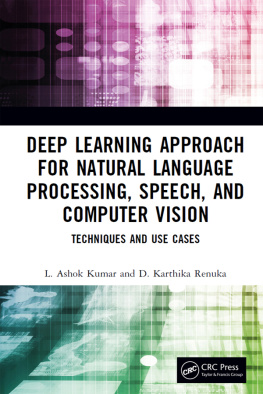

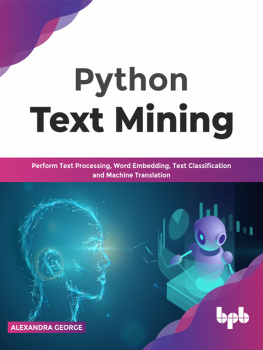
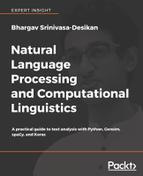
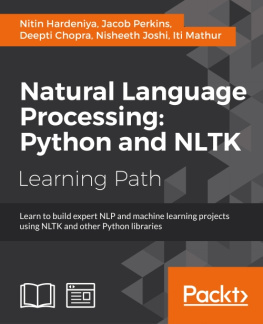
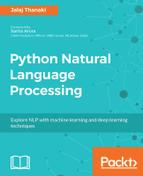

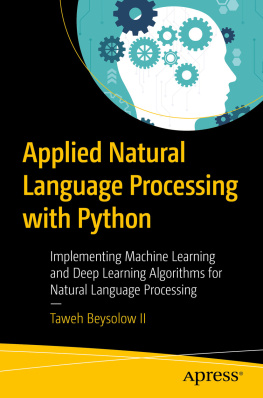
![Bhargav Srinivasa-Desikan [Bhargav Srinivasa-Desikan] - Natural Language Processing and Computational Linguistics: A Practical Guide to Text Analysis With Python, Gensim, spaCy, and Keras](/uploads/posts/book/119021/thumbs/bhargav-srinivasa-desikan-bhargav.jpg)
